Lebanese Shia Muslims
Lebanese Shia Muslims (Arabic: المسلمون الشيعة اللبنانيين), historically known as Shia Muslims or Muslims Shia (Arabic: متاولة), refers to Lebanese people who are adherents of the Shia branch of Islam in Lebanon, which is the largest Muslim denomination in the country. Shia Islam in Lebanon has a history of more than a millennium. According to the CIA World Factbook, Shia Muslims constituted an estimated 22.5% of Lebanon's population in 2020 (see below). (Sources provided do not support the claim stated in this Wikipedia article or the purported 22%. One of the sources provided states otherwise at over 30%).
| Languages | |
|---|---|
| Vernacular: Lebanese Arabic | |
| Religion | |
| Islam (Shia Islam) |
Most of its adherents live in the northern and western area of the Beqaa Valley, Southern Lebanon and Beirut. The great majority of Shia Muslims in Lebanon are Twelvers, with an Alawite minority numbering in the tens of thousands in north Lebanon.
Under the terms of an unwritten agreement known as the National Pact between the various political and religious leaders of Lebanon, Shias are the only sect eligible for the post of Speaker of Parliament.[1][2][3][4]
History
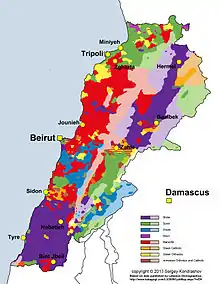
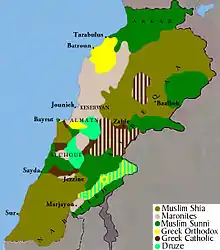
Origins
The cultural and linguistic heritage of the Lebanese people is a blend of both indigenous Phoenician elements and the foreign cultures that have come to rule the land and its people over the course of thousands of years. In a 2013 interview the lead investigator, Pierre Zalloua, pointed out that genetic variation preceded religious variation and divisions: "Lebanon already had well-differentiated communities with their own genetic peculiarities, but not significant differences, and religions came as layers of paint on top. There is no distinct pattern that shows that one community carries significantly more Phoenician than another."[5]
Haplogroup J2 is also a significant marker in throughout Lebanon (~30%). This marker found in many inhabitants of Lebanon, regardless of religion, signals pre-Arab descendants, including the Phoenicians and Aramaens. These genetic studies demonstrate that there are no significant differences between the Muslims and non-Muslims of Lebanon.[6] Genealogical DNA testing has shown that 21.3% of Lebanese Muslims (non-Druze) belong to the Y-DNA haplogroup J1 compared with non-Muslims at 17%.[7] Although Haplogroup J1 is most common in Arabian peninsula, studies have shown that it has been present in the Levant since the Bronze age[8] (3300-1200 BC) and does not necessarily indicate Arab descent,[9] with the main exception being the Arabian subclade of J1-FGC12 occurring at no more than 3% among Shias and Sunnis. Other haplogroups present among Lebanese Shia include E1b1b (19%), G-M201 (10%), R1b, and T-L206 occurring at smaller, but significant rates.[10]
In a 2020 study published in the American Journal of Human Genetics, Authors showed that there is substantial genetic continuity in Lebanon since the Bronze Age interrupted by three significant admixture events during the Iron Age, Hellenistic, and Ottoman period, each contributing 3%–11% of non-local ancestry to the admixed population.[11]
Genetics aside, the population of Lebanon was mainly Canaanite who began to speak Aramaic. Under Byzantine rule, this Aramean population was Hellenized and adopted the Greek language alongside their native Aramaic. It is important to note that most villages and towns in Lebanon today have Aramaic names, reflecting this heritage. Lebanon was also a home for many other historic peoples; North Lebanon and the northern Bekaa Valley were areas of Amurru kingdom of the Amorites in the Bronze Age. Aramaeans, who formed kingdoms nearby in Damascus and Hamath, came to dominate in the Bekaa, where Hazael the Aramaean king might have been born. While Aramaic was spoken by the rural populations, Greek was spoken in the urban communities and among traders; Beirut became the only fully Latin speaking city in the whole east. Alongside the natives, minor pockets of Greeks, Arabs, Persians, and other populations from the Near East and Mediterranean world assimilated into the native population living in Lebanon, over the course of history. Among these pre-Islamic Arabs, Banu Amela has importance for the Lebanese Shia for adopting and nurturing Shi'ism in the southern population. Other famous Arabs include Tanukhids and possibly Itureans. As the Islamic expansion reached Lebanon, these Arab tribes received the most power which encouraged the rest of the population to adopt Arabic as the main language.[12]
Early Islamic, Mamluk and Ottoman rule
The origin of the Shia Muslim community in Lebanon and surrounding regions are not entirely clear. However, the spread of Shia Islam is most likely tied to the dominance of different political entities in the early 9th and 10th centuries, and also to early Shia groups seeking refuge from Umayyad and Abbasid persecution.
Shia groups most likely existed in the territorial domain of modern-day Lebanon since the early 8th century. In all likeliness - this presence was enforced by the Hamdanids, Mirdasids and Fatimids who came to dominate the region in the 9th, 10th and 11th centuries respectively. Shias populated and spread in numerous cities on the coast; most famously Tripoli, ruled by "Banu Ammar" family, and Tyre which although predominantly Shia, was ruled by Sunni "Abi Aqil" family. Famous notables from the two cities include the famous poet "Abdul-Muḥsin ibn Ghalbūn al-Sūri" (c. 950-1028 CE) from Tyre, and the famous Shi'i cleric "Abul-Fatḥ Muḥammad bin Ali bin Uthman al-Karākijī al-Tarābulsī" (d. 1026 CE) from Tripoli.
Historical attestations of Shiites are present in several historical books and documents written by famous travelers and chroniclers of the time. One of many is Nasir Khusraw, who visited the region in 11th century (c. 1040) and wrote: "As for Tyre, most of its inhabitants are Twelver Shias. And of the famous countryside towns (in Jabal 'Amil) are Tebnine, Hunin, Qadas and Shqif ..".[13] Nasir Khusraw also wrote, to his notice, that the majority of the inhabitants of Tiberias and Safed, and half of Jerusalem's population were Shia Muslims.[13] In another of his reports, during a visit to Tripoli in 1047, he estimated the size of the population in Tripoli to be around 20,000 and the whole population were Shia Muslims.[14] The report mentions that the Fatimid Sultan raised a mighty army from Tripoli to defend it against Byzantine, Frankish, Andalusian and Moroccan invasions and raids.[14] Similar to Tripoli and Tyre, Beirut seems to have had a substantial Shiite population in the crusader and Mamluk periods. Mamluk-era chroniclers report in 1384 about an armed rebellion led by the Shias of Beirut against the Mamluks, but it was peacefully settled by the Buhturids.
The famous Baghdadi traveler al-Ya‘qūbī (d. 897 CE), a Shia himself, reported in his famous book (Kitab al-Buldan): "[..] And as for Baalbek, its people are Persian and around it are people from Hamadan [..]", Hamadan being a Yemenite tribe famous for its allegiance to Ali and participated in all of his battles, and was known to be a bastion of early Shiism.[15] Complementary to this account is Yaqut al-Hamawi's (d. 1229 CE) words in his book "Mu'jam al-Buldan" (Dictionary of Countries), describing the people of Homs as "a people who viciously supported Muawiya, now they are ghulat of Ali" describing some of them as Nusayris who were originally Imamiyyah (Twelvers).[16]
Qutb ad-Dine al-Yūnīnī, the famous Sunni scholar from Baalbek, mentioned one of the earliest Shia scholars from Baalbek "Najm ad-Din ibn Malli al-Ansari al-Ba'labakki" (b. 617 AH/1195 CE), a student of "Ibn Ma'qal al-Homsi", a native of Homs who studied at Hillah, a famous Shiite seminar in Iraq, and spent the rest of his life in Baalbek. Najm ad-Din is said to have gathered 10,000 men to resist the Mongol invasions and conquests through guerilla warfare tactics, often attacking Mongols at night. Under Ayyubid rule however, the city of Baalbek was of a Sunni Hanbali majority, while the Shiites were confined to the rural villages of the Bekaa valley. This is often considered as a glimpse of the demographic shifts and changes occurring in the city at that time.
Shia groups are recorded to have populated northern region of "Dinnieh". The region named after a Shia group "al zanniyyah" الظّنيّة, possibly means "The ones who doubt", referring to the rejection of and doubt over the legitimacy of the first three caliphs; a core tenant for mainstream Shia belief. This spread was possibly tied with the movement of Nusayri missionaries from Aleppo into the coastal mountains of Syria and Lebanon in 1030. According to William Harris, proselytization would have seeped into Keserwan by 1070.[12]
Furthermore, Under persecution by the Zengid dynasty, many Isma'ilis in the regions of Damascus and Aleppo are said to have fled west during the 12th century, with many settling in the mountains of Lebanon,[17] where the Alawites had earlier taken refuge—and where their brethren in the Assassins were cultivating a fearsome reputation as they staved off armies of Crusaders and Sunnis alike for many years.
As such, the earliest historical attestations of Shiite groups mention their presence in Galilee and Southern Lebanon, the Beqaa Valley as far as Homs in Syria and Tripoli and its countryside.[14][15][13][18]
After Tripoli and Tyre fell at the hands of the Crusaders and Venetians in 1109 and 1124 respectively, Shias were forced to move to the mountains and hills adjacent to their cities. As with the Druze country, Jabal Amil probably received a population influx as a result of the first crusade. The Franks took the Jordan Valley, Tiberias, Nablus, and much of the Galilee in a thrust northward from Jerusalem in late 1099. Many Shia would have fled into southern Lebanon, where the Franks only extended their rule with the fortifications in Tebnine in 1106.[12]
The growth of Shia Islam in Lebanon is believed to have halted in the beginning of the 14th century, and subsequently Shia communities decreased in size. This change of events may be traced to the Mamlouks, who sent numerous military expeditions to subdue the autonomous Shias living in Keserwan, a mountainous region overlooking the coastal area north of Beirut. The first two Mamluke expeditions were unsuccessful. The third expedition however was successful in subduing them and many Shias were brutally slaughtered and forced to leave their faith but some were granted permission to stay. An influx of Shias penetrated the Beqaa Valley, while others found a new safe haven in Jezzine and later further south.[19][18]
Shias remained as the imperative force in Keserwan, and had significant presence in Christian dominated Jbeil District and Ftuh in the 16th century, until they were ousted from Keserwan by the 17th century. Shia villagers also inhabited Bsharri District, Batroun District and Zgharta District, according to the names mentioned in 1519 census.[18] Between 1519 and 1571, there seems to have been a total decline in Shia populations living in Bsharri, Batroun and Zgharta, and abandonment of the villages; a population bottleneck possibly attributed to the reappearance of the plague in the mid-16th century and the financial difficulties at the time. In 1519 census done by the Ottomans, villages in Keserwan and Ftuh are recorded as belonging to an anonymous Shia family "Raḥal", which disappeared from subsequent records.[18] Shia families started moving from the eastern peripherals of the Bekaa to Baalbek due to conflicts with other Sunni inhabitants of the region during the 15th century. During Yunus Harfushs' rule in 1616, Feudal Shia families started moving from the south northward to Baalbek because of conflict with Druze Ma'anids.[20]
The Shiite Mustarah family apparently had control of the Munaytra district as early as 1482. In the course of the seventeenth century, the Mustarahs and other Shiite notables would be driven out by the Hamadas and eventually takeup farming in the Bekaa. In the province of Tripoli, the Hamada family of the Wadi 'Almat came to prominence around the same time as lieutenants of the Sayfa dynasty, before being charged, on account of their endogenous tribal organization and ruthless efficiency, with multiple tax collection assignments in the Shiite- and Christian-dominated hinterland of Mount Lebanon.[21][18]
Keserwan began to lose its Shia character under the Assaf Sunni Turkmen whom the Mamluks appointed as overlords of the area in 1306 and in 1517 by the Ottomans. The process intensified around 1545 when the Maronites started migrating to Keserwan and Byblos, encouraged by the Assafs, who sought to use them as a counterweight to the Shia Hamade sheikhs who reemerged in Keserwan in the late 16th century. Contemporary with the Hamade family were the Sha'irs who were assigned tax collectorship for the Batroun District, but lost control after continuous conflict with their former Shia counterparts, in the late 17th century.[18] When in 1605 the Druze emir Fakhr al-Din Ma'n II took over Keserwan, he entrusted its management to the Khazen Maronite family. The Khazens gradually colonized Keserwan, purchasing Shia lands and founding churches and monasteries. They emerged as the predominant authority in the region at the expense of the Shia Hamedeh clan. By the end of the eighteenth century, the Khazens owned Keserwan and only a few Shia villages survived. In addition, during the late 17th century, the region was subject to decades of bloody conflict between Ottoman authorities aided by other feudal families, and the Hamade's and their regional base of support. In 1686, 8,000 Ottoman soldiers attacked and burned over 40 villages in the region, and killed over a thousand Shia irregulars fighting on behalf of the Hamade's. The Hamade clan eventually fell out of the favor of the Ottomans and were forced to relocate to Hermel in 1773.
The Harfushes were already well established in the Bekaa on the eve of the Ottoman conquest. The late-Mamluk popular historian Ibn Tawq identifies an Ibn Harfush as muqaddam of the Anti-Lebanon mountains village Jubbat 'Assal as early as 1483; Ibn al-Himsi and Ibn Tulun mention one as deputy (na'ib) of Baalbek in 1498. The Harfushes of Baalbek received the iltizam concesion for the Bekaa as well as a rank in the provincial military hierarchy (the district governosrhip of Homs or Tadmur) in recognition of their long-standing position of dominance within local Shiite society.[21] In the seventeenth century, the Harfush emirate of the Bekaa valley and the Hamadas of Mt. Lebanon rivalled the territorial extension and power of the Druze emirate of the Shuf. Unlike the Druze, the Shiite emirs were regularly denounced for their religious identity and persecuted under Ebu's-Suud's definition of Kızılbaş heretics. The Harfush rule however ended in 1865 when they were deported to Edirne.
The best-known Shiite taxlordship in Jabal ‘Amil was that of the ‘Ali al-Saghirs, who controlled the four cantons south of the Litani River (Hunin, Ma‘araka, Qana, Tibnin) collectively known as the Bilad Bishara for much of the seventeenth and eighteenth centuries. The house of ‘Ali al-Saghir first appears (along with the Munkars and Shukrs) as a local opponent of the Ma‘nids in 1617. According to ‘Amili tradition, ‘Ali and Husayn al-Saghir, reputed descendants of a leading Shiite tribe from the past, went on to eliminate the rival Suduns and Shukrs in 1639 and 1649 respectively, and therewith established a single-family Shiite reign over the entire southern Jabal ‘Amil that would last until the tyrannical rule of Cezzar Ahmed Paşa in the eighteenth century.[18]
Husam al-Din Bishara took control of Jabal Amil after Frankish retreat in 1187. The Wa'il clan, ancestors of the modern Asa'ad family, who entered Jabal Amil with Salah al-Din, took over local leadership in the early thirteenth century. Under the Mamluks, they competed with the Shukr chiefs of Bint Jbeil. Another family called Sudun appeared in southern Jabal Amil by the early sixteenth century. "Sudun" was known as the na'ib of Damascus in 1478. During the 17th century, Ali al-Saghirs, belonging to the greater al-Wa'ili clan, in Jabal 'Amil would become the lords of Southern Lebanon.[22]
In the 18th century, the most powerful Shia sheikh was Nassif al-Nassar. Nasif seems to have inherited the leadership of the ‘Ali al-Saghir clan in 1749/50 after his brother Zahir Nassar.[18] Nasif and Zahir challenged the authority of the Ottoman governors of Sidon and Damascus and their Druze allies who dominated Mount Lebanon. When this coalition of Ottoman forces launched an offensive against Nasif and Zahir in 1771, the forces of the latter two routed them in Lake Hula.[23] After the Battle of Lake Hula, Nasif's forces, who numbered some 3,000 horsemen, decisively defeated a 40,000-strong Druze force under Emir Yusuf Shihab,[24] killing some 1,500 Druze warriors.[23] According to Baron Francois de Tott, a French mercenary of the Ottoman Army, Nasif's cavalry "put them to flight at the first onset".[24]
This prosperity, however, ended with the Ottoman appointment of Ahmad al-Jazzar as governor of Sidon province (1775–1804). Jazzar crushed the military power of the Shia clan leaders and burned the libraries of the religious scholars using the Druze tribes established in the Shouf, mainly the strong Nakad family, allied to the Maan. He established a centralized administration in the Shia areas and brought their revenues and cash crops under his domain. By the late eighteenth century, the Shias of the Jabal 'Amil lost their independent spirit and adopted an attitude of political defeat. Al-Jezzar was nicknamed "the butcher" and a big population of the Shia were killed under his rule in Lebanon.
Relations with Iranian Shias
During most of the Ottoman period, the Shia largely maintained themselves as 'a state apart', although they found common ground with their fellow Lebanese, the Maronites; this may have been due to the persecutions both sects faced. They maintained contact with the Safavid dynasty of Persia, where they helped establish Shia Islam as the state religion of Persia during the Safavid conversion of Iran from Sunni to Shia Islam. Since most of the population embraced Sunni Islam and since an educated version of Shia Islam was scarce in Iran at the time, Isma'il imported a new Shia Ulema corps from traditional Shiite centers of the Arabic speaking lands, such as Jabal Amil (of Southern Lebanon), Bahrain and Southern Iraq in order to create a state clergy. Isma'il offered them land and money in return for their loyalty. These scholars taught the doctrine of Twelver Shia Islam and made it accessible to the population and energetically encouraged conversion to Shia Islam.[25][26][27][28] To emphasize how scarce Twelver Shia Islam was then to be found in Iran, a chronicler tells us that only one Shia text could be found in Isma'il's capital Tabriz.[29] Thus it is questionable whether Isma'il and his followers could have succeeded in forcing a whole people to adopt a new faith without the support of the Arab Shia scholars.[30]
These contacts further angered the Ottoman Sultan, who had already viewed them as religious heretics. The Sultan was frequently at war with the Persians, as well as being, in the role of Caliph, the leader of the majority Sunni community. Shia Lebanon, when not subject to political repression, was generally neglected, sinking further and further into the economic background. Towards the end of the eighteenth century the Comte de Volmy was to describe the Shia as a distinct society.
French mandate period
Following the official declaration of the French Mandate of Greater Lebanon (Le Grand Liban) in September 1920, anti-French riots broke out in the predominantly Shia areas of Jabil ‘Amil and the Beqaa Valley. In 1920 and 1921, rebels from these areas, led by Adham Khanjar and Sadiq Hamzeh, attacked French military bases in Southern Lebanon.[31] During this period of chaos, also several predominantly Christian villages in the region were attacked due to their perceived acceptance of French mandatory rule, including Ain Ebel. Eventually, an unsuccessful assassination attempt on French High Commissioner Henri Gouraud led to the execution of Adham Khanjar.[31] At the end of 1921, this period of unrest ended with a political amnesty offered by the French mandate authorities for all Shi’is who had joined the riots, with the intention to bind the Shia community in the South of Lebanon to the new Mandate state.[31]
Education
During the 1920’s and 1930’s, educational institutions became places for different religious communities to construct nationalist and sectarian modes of identification.[32] Shia leaders and religious clergy supported educational reforms in order to improve the social and political marginalization of the Shia community and increase their involvement in the newly born nation-state of Lebanon.[33] This led to the establishment of several private Shia schools in Lebanon, among them The Charitable Islamic ʿĀmili Society (al-Jamʿiyya al-Khayriyya al-Islāmiyya al-ʿĀmiliyya) in Beirut and The Charitable Jaʿfari Society (al-Jamʿiyya al-Khayriyya al-Jaʿfariyya) in Tyre.[33] While several Shia educational institutions were established before and at the beginning of the mandate period, they often ran out of support and funding which resulted in their abolishment.[33]
The primary outlet for discussions concerning educational reforms among Shia scholars was the monthly Shiite journal al-‘Irfan. In order to bring their demands (muṭālabiyya) to the attention of the French authorities, petitions were signed and presented to the French High Commissioner and the Service de l’Instruction Publique.[34] This institution – since 1920 headquartered in Beirut- oversaw every educational policy regarding public and private school in the mandate territories.[35] According to historian Elizabeth Thompson, private schools were part of “constant negotiations” between citizen and the French authorities in Lebanon, specifically regarding the hierarchical distribution of social capital along religious communal lines.[36] During these negotiations, petitions were often used by different sects to demand support for reforms. For example, the middle-class of predominantly urban Sunni areas expressed their demands for educational reforms through petitions directed towards the French High Commissioner and the League of Nations.[37]
Ja’fari shar’ia courts
In January 1926, the French High Commissioner officially recognized the Shia community as an “independent religious community,” which was permitted to judge matters of personal status “according to the principles of the rite known by the name of Ja’fari.”[38] This meant that the Shiite Ja'fari jurisprudence or madhhab was legally recognized as an official madhhab, and held judicial and political power on multiple levels.[39] The institutionalization of Shia Islam during this period provoked discussions between Shiite scholars and clergy about how Shiite orthodoxy should be defined. For example, discussions about the mourning of the martyrdom of Imam Husain during Ashura, which was a clandestine affair before the 1920’s and 1930’s, led to its transformation into a public ceremony.[40]
On the other hand, the official recognition of legal and religious Shiite institutions by the French authorities strengthened a sectarian awareness within the Shia community. Historian Max Weiss underlines how “sectarian claims were increasingly bound up with the institutionalization of Shi’i difference."[41] With the Ja’fari shar’ia courts in practice, the Shia community was deliberately encouraged to "practice sectarianism" on a daily basis.
Sub-groups
Shia Twelvers (Metouali)
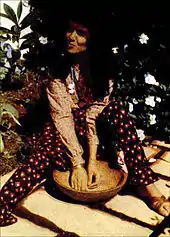
Shia Twelvers in Lebanon refers to the Shia Muslim Twelver community with a significant presence all over Lebanon including the Mount Lebanon (Keserwan, Byblos), the North (Batroun), the South, the Beqaa, Baabda District coastal areas and Beirut.
The jurisdiction of the Ottoman Empire was merely nominal in the Lebanon. Baalbek in the 18th century was really under the control of the Metawali, which also refers to the Shia Twelvers.[42] Metawali, Metouali, or Mutawili, is an archaic term used to specifically refer to Lebanese Twelver Shias in the past. Although it can be considered offensive nowadays, it was a way to distinguish the uniqueness and unity of the community. The term 'mutawili' is also the name of a trustee in Islamic waqf-system.
Seven Shia Twelver (Mutawili) villages that were reassigned from French Greater Lebanon to the British Mandate of Palestine in a 1924 border-redrawing agreement were depopulated during the 1948 Arab-Israeli War and repopulated with Jews.[43] The seven villages are Qadas, Nabi Yusha, al-Malikiyya, Hunin, Tarbikha, Abil al-Qamh, and Saliha.[44]
In addition, the Shia Twelvers in Lebanon have close links to the Syrian Shia Twelvers.[45]
Alawites
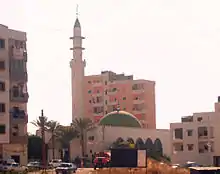
There are an estimated 40,000[46][47][48] Alawites in Lebanon, where they have lived since at least the 16th century.[49] They are recognized as one of the 18 official Lebanese sects, and due to the efforts of an Alawite leader Ali Eid, the Taif Agreement of 1989 gave them two reserved seats in the Parliament. Lebanese Alawites live mostly in the Jabal Mohsen neighbourhood of Tripoli, and in 10 villages in the Akkar region,[50][51][52] and are mainly represented by the Arab Democratic Party. Bab al-Tabbaneh, Jabal Mohsen clashes between pro-Syrian Alawites and anti-Syrian Sunnis have haunted Tripoli for decades.[53]
Isma'ilis
Isma'ilism, or "Sevener Shi'ism", is a branch of Shia Islam which emerged in 765 from a disagreement over the succession to Muhammad. Isma'ilis hold that Isma'il ibn Jafar was the true seventh imam, and not Musa al-Kadhim as the Twelvers believe. Isma'ili Shi'ism also differs doctrinally from Imami Shi'ism, having beliefs and practices that are more esoteric and maintaining seven pillars of faith rather than five pillars and ten ancillary precepts.
Though perhaps somewhat better established in neighbouring Syria, where the faith founded one of its first da'wah outposts in the city of Salamiyah (the supposed resting place of the Imam Isma'il) in the 8th century, it has been present in what is now Lebanon for centuries. Early Lebanese Isma'ilism showed perhaps an unusual propensity to foster radical movements within it, particularly in the areas of Wadi al-Taym, adjoining the Beqaa valley at the foot of Mount Hermon, and Jabal Shuf, in the highlands of Mount Lebanon.[54]
The syncretic beliefs of the Qarmatians, typically classed as an Isma'ili splinter sect with Zoroastrian influences, spread into the area of the Beqaa valley and possibly also Jabal Shuf starting in the 9th century. The group soon became widely vilified in the Islamic world for its armed campaigns across throughout the following decades, which included slaughtering Muslim pilgrims and sacking Mecca and Medina—and Salamiyah. Other Muslim rulers soon acted to crush this powerful heretical movement. In the Levant, the Qarmatians were ordered to be stamped out by the ruling Fatimid, themselves Isma'ilis and from whom the lineage of the modern Nizari Aga Khan is claimed to descend. The Qarmatian movement in the Levant was largely extinguished by the turn of the millennium.[54]
The semi-divine personality of the Fatimid caliph in Isma'ilism was elevated further in the doctrines of a secretive group which began to venerate the caliph Hakim as the embodiment of divine unity. Unsuccessful in the imperial capital of Cairo, they began discreetly proselytising around the year 1017 among certain Arab tribes in the Levant. The Isma'ilis of Wadi al-Taym and Jabal Shuf were among those who converted before the movement was permanently closed off a few decades later to guard against outside prying by mainstream Sunni and Shia Muslims, who often viewed their doctrines as heresy. This deeply esoteric group became known as the Druze, who in belief, practice, and history have long since become distinct from Isma'ilis proper. Druze constitute 5.2% of the modern population of Lebanon and still have a strong demographic presence in their traditional regions within the country to this day.[54]
Due to official persecution by the Sunni Zengid dynasty that stoked escalating sectarian clashes with Sunnis, many Isma'ilis in the regions of Damascus and Aleppo are said to have fled west during the 12th century. Some settled in the mountains of Lebanon, while others settled further north along the coastal ridges in Syria,[17] where the Alawites had earlier taken refuge—and where their brethren in the Assassins were cultivating a fearsome reputation as they staved off armies of Crusaders and Sunnis alike for many years.
Once far more numerous and widespread in many areas now part of Lebanon, the Isma'ili population has largely vanished over time. It has been suggested that Ottoman-era persecution might have spurred them to leave for elsewhere in the region, though there is no record or evidence of any kind of large exodus.[55]
Isma'ilis were originally included as one of five officially-defined Muslim sects in a 1936 edict issued by the French Mandate governing religious affairs in the territory of Greater Lebanon, alongside Sunnis, Twelver Shias, Alawites, and Druzes. However, Muslims collectively rejected being classified as divided, and so were left out of the law in the end. Ignored in a post-independence law passed in 1951 that defined only Judaism and Christian sects as official, Muslims continued under traditional Ottoman law, within the confines of which small communities like Isma'ilis and Alawites found it difficult to establish their own institutions.[56]
The Aga Khan IV made a brief stop in Beirut on 4 August 1957 while on a global tour of Nizari Isma'ili centres, drawing an estimated 600 Syrian and Lebanese followers of the religion to the Beirut Airport in order to welcome him.[57] In the mid-1980s, several hundred Isma'ilis were thought to still live in a few communities scattered across several parts of Lebanon.[58] Though they are nominally counted among the 18 officially-recognised sects under modern Lebanese law,[59] they currently have no representation in state functions[60] and continue to lack personal status laws for their sect, which has led to increased conversions to established sects to avoid the perpetual inconveniences this produces.[61]
War in the region has also caused pressures on Lebanese Isma'ilis. In the 2006 Lebanon War, Israeli warplanes bombed the factory of the Maliban Glass company in the Beqaa valley on 19 July. The factory was bought in the late 1960s by the Madhvani Group under the direction of Isma'ili entrepreneur Abdel-Hamid al-Fil after the Aga Khan personally brought the two into contact. It had expanded over the next few decades from an ailing relic to the largest glass manufacturer in the Levant, with 300 locally hired workers producing around 220,000 tons of glass per day. Al-Fil closed the plant down on 15 July just after the war broke out to safeguard against the deaths of workers in the event of such an attack, but the damage was estimated at a steep 55 million US dollars, with the reconstruction timeframe indefinite due to instability and government hesitation.[62]
Geographic distribution within Lebanon
Lebanese Shia Muslims are concentrated in south Beirut and its southern suburbs, northern and western area of the Beqaa Valley, as well as Southern Lebanon.[63]
Demographics
The last census in Lebanon in 1932 put the numbers of Shias at 20% of the population (200,000 of 791,700).[65] A study done by the Central Intelligence Agency (CIA) in 1985 put the numbers of Shias at 41.247% of the population (919,000 of 2,228,000).[65]
Twenty seven years after their 1985 estimate, a 2020 CIA study reports that the Shia Muslims constituted an estimated 22% of Lebanon's population—nearly half as much as CIA's own estimate in 1985. (Sources provided do not support the claim stated in this Wikipedia article or the purported 22%. One of the sources provided states otherwise at over 30%). [64]
In 2020 the CIA World Factbook stated that Shia Muslims constitute 22.5% of Lebanon's population.[66] (Sources provided do not support the claim stated in this Wikipedia article or the purported 22%. One of the sources provided states otherwise at over 30%).
| Year | Shiite Population | Total Lebanese Population | Percentage |
|---|---|---|---|
| 1932 | 40,000 | 791,700 | 10%[65] |
| 1956 | 90,605 | 1,407,868 | 11.8% |
| 1975 | 300,500 | 2,550,000 | 26.2% |
| 1984 | 360,000 | 3,757,000 | 23.8% |
| 1988 | 600,000 | 4,044,784 | 22.8% |
| 2020 | 980,000 | 6,082,000 | 22.5% |
Notable Lebanese Shia Muslims
 | 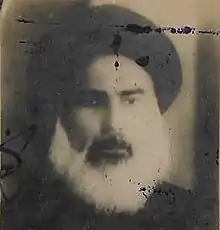 | 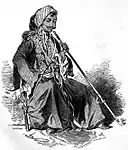 | 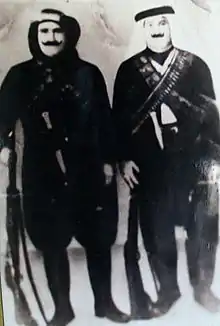 |  | 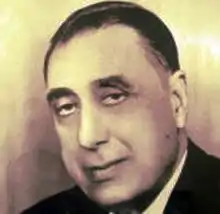 | _(cropped).jpg.webp) | |
 |  | 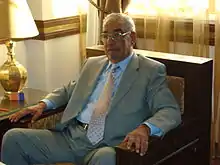 | 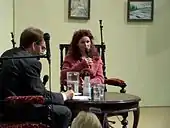 |  |  |
- Abul Hasan Ali bin Muhammad al-Tarabulsi (d. 1070) – Emir of Tripoli and the builder of Dar al-'ilm, one of the biggest libraries in the medieval world, in Tripoli
- Muhammad Jamaluddin al-Makki al-ʿĀmili (1334-1385) – A Shi'a scholar, born in Jabal A'mel in Southern Lebanon, known as "Shahid Awwal"
- Nur-al-Din al-Karaki al-ʿĀmilī (1465-1534) – Shiite scholar who was a member of the Safavid court
- Zayn al-Din al-Juba'i al-'Amili (1506-1558) – Known as "Shahid Thani", one of the most prominent Shia fiqh scholars of his time
- Ḥussein al-Harithi (1512-1576) – Shia scholar and poet; father of Sheikh al-Baha'i
- Muhammad Saḥib al-Madarik (1524-1587) – Shia scholar and author of one of the most extensive works on Islamic Shia jurisprudence
- Hasan Saḥib al-Ma'alim (1537-1589) – Shia scholar and famous ascetic, son of Shahid al-Thani
- Ali bin Musa al-Harfush (1537-1589) – Emir of Bekaa, his dominion extended as far as Palmyra in Syria
- Bahāʾ al-dīn al-ʿĀmilī (1547-1621) - Shia Islamic scholar, philosopher, architect, mathematician, astronomer and poet who lived in the late 16th and early 17th centuries and died in Safavid Iran
- Al-Ḥurr al-ʿĀmilī (1624-1693) – A muhaddith and a prominent Twelver Shi’a scholar, Born in Jabal A'mel in southern Lebanon
- Yunus al-Harfushi (d. 1625) – Emir of Bekaa, one of the prime opponents of Fakhreddine II
- Nassif al-Nassar (d. 1781) – Sheikh of Southern Lebanon, won numerous battles against his opponents
- Musa al-Sadr – Spiritual leader and founder of the Amal movement, philosopher and Shi'a religious leader from a long line of distinguished clerics tracing their ancestry back to Jabal Amel
- Hussein el Husseini – Statesman, co-founder of the Amal movement and Speaker of Parliament
- Mohammad Hussein Fadlallah – Spiritual Leader and Shia Grand Ayatollah
- Hassan Nasrallah – Leader of the group Hezbollah
- Imad Mughniyah – Lebanese, Hezbollah's former Chief of Staff
- Ahmad Rida – Shiite scholar who participated in the creation of the Kingdom of Syria under Faisal
- Adham Khanjar – Lebanese revolutionary who attempted to assassinate Henri Gouraud and as a result he was executed in 1923
- Tawfiq Hawlo Haidar – Lebanese revolutionary who took part in the Great Syrian Revolt (1925 - 1927)
- Mustafa Badreddine – Military leader in Hezbollah and both the cousin and brother-in-law of Imad Mughniyah
- Adel Osseiran – Speaker of the Lebanese Parliament, and one of the founding fathers of the Lebanese Republic
- Sabri Hamade – Speaker of the Parliament and political leader
- Ahmed al-Asaad – Speaker of the parliament and political leader
- Kamel Asaad – Speaker of the parliament and political leader
- Nabih Berri – Speaker of the Parliament and political leader of Amal Movement
- Abbas Ibrahim – General director of the General Directorate of General Security
- Wafiq Jizzini – Former General director of the General Directorate of General Security
- Jamil Al Sayyed – Former General director of the General Directorate of General Security
- Hussein al-Musawi – Founder of Islamic Amal militia in 1982
- Assem Qanso – Former leader of the Lebanese Ba'ath
- Ali Qanso – Member of cabinet, former president of the Syrian Social Nationalist Party
- Muhsin Ibrahim – Lebanese Communist and leader of the Communist Action Organization in Lebanon
- Zaynab Fawwaz – Pioneering Lebanese Shiite novelist, playwright, poet and historian of famous women
- Ragheb Alama – Singer, composer, television personality, and philanthropist
- Amal Saad-Ghorayeb – Lebanese writer and scholar
- Diana Haddad – Singer and television personality
- Bushra Khalil – Lebanese lawyer, represented Saddam Hussein during his trial
- Haifa Wehbe – Model, actress, and singer[68]
- Assi El Helani – Famous singer
- May Hariri – Model, actress, and singer
- Alissar Caracalla – Lebanese Dance choreographer
- Okab Sakr – Lebanese journalist
- Rammal Rammal – Lebanese Physicist
- Ali Chamseddine – Lebanese Physicist
- Hassan Bechara – Lebanese wrestler, won the bronze medal in the men's Greco-Roman Super Heavyweight category
- Roda Antar - Lebanese football manager, Former captain of Lebanese national team and player who currently coaches Racing Beirut in the Lebanese Football League.
- Moussa Hojeij – Lebanese football player and manager at Nejmeh SC
- Malek Maktabi – Lebanese journalist and television presenter husband of Nayla Tueni
- Mouhamed Harfouch – Brazilian-Lebanese actor
- Fouad Ajami – university professor and writer on Middle Eastern issues
- Rima Fakih – winner of the 2010 Miss USA title; later converted from Shia Islam to Maronite Christianity[69]
- Hanan al-Shaykh – Lebanese author
- Husayn Muruwwa – Marxist philosopher[70]
These are notable Lebanese Shia Muslim families:
- El-Husseini – Famous Sayyed clerical and political family descended from Ali ibn abi Taleb and the Prophet Muhammad through Zayd ibn Ali
- Sharaf al-Din – Famous Sayyed family of distinguished scholars and clerics tracing back to Ibrahim son of Musa al-Kadhim
- Hamade – Feudal Lords and tax collectors of Keserwan, Jbeil, Batroun and Bsharri, famous political family[71][72]
- Assaf – Emirs of Keserwan. Historically a Sunni dynasty, the family became Shia later on[73]
- Harfush – Emirs of Baalbek and Bekaa[73]
- Ali as-Saghir, El Assaad – Lords of southern Lebanon, political family[73]
- Sha'ir – Feudal Lords and tax collectors of Batroun district during late 16th and middle 17th centuries[73]
- Mustarah – Lords of Ftuh and Munaytirah districts in 15th century and 16th century[73]
- Osseiran – Political family
- El Zein – Feudal landowners
- Hamdan – Descendants of Hamdanids of Aleppo
- Khalil – Feudal landowners
- Qansuh – Descendants of Qansuh al-Ghuri
See also
References
- "Lebanon-Religious Sects". Global security.org. Retrieved 2010-08-11.
- "March for secularism; religious laws are archaic". NOW News. Retrieved 2010-08-11.
- "Fadlallah Charges Every Sect in Lebanon Except his Own Wants to Dominate the Country". Naharnet. Retrieved 2010-08-11.
- "Aspects of Christian-Muslim Relations in Contemporary Lebanon". Macdonald.hartsem.edu. Archived from the original on 2011-07-25. Retrieved 2010-08-11.
- Maroon, Habib (31 March 2013). "A geneticist with a unifying message". Nature Middle East. doi:10.1038/nmiddleeast.2013.46.
- Zalloua, Pierre A., Y-Chromosomal Diversity in Lebanon Is Structured by Recent Historical Events, The American Journal of Human Genetics 82, 873–882, April 2008
- Haber, Marc (2011). "Influences of history, geography, and religion on genetic structure: the Maronites in Lebanon". European Journal of Human Genetics. 19 (3): 334–340. doi:10.1038/ejhg.2010.177. PMC 3062011. PMID 21119711.
- Skourtanioti, Eirini; Erdal, Yilmaz S.; Frangipane, Marcella; Balossi Restelli, Francesca; Yener, K. Aslıhan; Pinnock, Frances; Matthiae, Paolo; Özbal, Rana; Schoop, Ulf-Dietrich; Guliyev, Farhad; Akhundov, Tufan; Lyonnet, Bertille; Hammer, Emily L.; Nugent, Selin E.; Burri, Marta; Neumann, Gunnar U.; Penske, Sandra; Ingman, Tara; Akar, Murat; Shafiq, Rula; Palumbi, Giulio; Eisenmann, Stefanie; d'Andrea, Marta; Rohrlach, Adam B.; Warinner, Christina; Jeong, Choongwon; Stockhammer, Philipp W.; Haak, Wolfgang; Krause, Johannes (2020). "Genomic History of Neolithic to Bronze Age Anatolia, Northern Levant, and Southern Caucasus". Cell. 181 (5): 1158–1175.e28. doi:10.1016/j.cell.2020.04.044. PMID 32470401. S2CID 219105572.
- Haber, Marc; Doumet-Serhal, Claude; Scheib, Christiana; Xue, Yali; Danecek, Petr; Mezzavilla, Massimo; Youhanna, Sonia; Martiniano, Rui; Prado-Martinez, Javier; Szpak, Michał; Matisoo-Smith, Elizabeth; Schutkowski, Holger; Mikulski, Richard; Zalloua, Pierre; Kivisild, Toomas; Tyler-Smith, Chris (2017-08-03). "Continuity and Admixture in the Last Five Millennia of Levantine History from Ancient Canaanite and Present-Day Lebanese Genome Sequences". The American Journal of Human Genetics. 101 (2): 274–282. doi:10.1016/j.ajhg.2017.06.013. ISSN 0002-9297. PMC 5544389. PMID 28757201.
- Haber, Marc; Platt, Daniel E; Badro, Danielle A; Xue, Yali; El-Sibai, Mirvat; Bonab, Maziar Ashrafian; Youhanna, Sonia C; Saade, Stephanie; Soria-Hernanz, David F (March 2011). "Influences of history, geography, and religion on genetic structure: the Maronites in Lebanon". European Journal of Human Genetics. 19 (3): 334–340. doi:10.1038/ejhg.2010.177. ISSN 1018-4813. PMC 3062011. PMID 21119711.
- Haber, Marc; Nassar, Joyce; Almarri, Mohamed A.; Saupe, Tina; Saag, Lehti; Griffith, Samuel J.; Doumet-Serhal, Claude; Chanteau, Julien; Saghieh-Beydoun, Muntaha; Xue, Yali; Scheib, Christiana L.; Tyler-Smith, Chris (2020). "A Genetic History of the Near East from an aDNA Time Course Sampling Eight Points in the Past 4,000 Years". American Journal of Human Genetics. 107 (1): 149–157. doi:10.1016/j.ajhg.2020.05.008. PMC 7332655. PMID 32470374.
- W., Harris, William (2012). Lebanon : a history, 600-2011. New York: Oxford University Press. ISBN 9780195181128. OCLC 757935847.
- al-Amin, Muhsin. أعيان الشّيعة, vol. I. p. 240.
- al-Qubadiani, Nasir ibn Khusraw. Safarnama (سفرنامه). p. 48.
- al-Ya‘qūbī, Aḥmad ibn Abī Ya‘qūb. Book of the Countries (Kitab al-Buldan).
- al-Hamawi, Yaqut. معجم البلدان (Dictionary of Countries).
- Mahamid, Hatim (September 2006). "Isma'ili Da'wa and Politics in Fatimid Egypt" (PDF). Nebula. p. 13. Retrieved 2013-12-17.
- Winter, Stefan (11 March 2010). The Shiites of Lebanon under Ottoman Rule, 1516–1788. Cambridge University Press. ISBN 9781139486811.
- Winter, Stefan (20 September 2016). A History of the 'Alawis: From Medieval Aleppo to the Turkish Republic. ISBN 9781400883028.
- حمادة, سعدون (2008). تاريخ الشيعة في لبنان.
- Stefan Winter, The Shiites of Lebanon under Ottoman Rule, 1516–1788 (Cambridge University Press, 2010).
- Harris, William (12 June 2012). Lebanon: A History, 600 - 2011. ISBN 9780199720590.
- Harris, 2012, p. 120
- Blanford, 2011, p. 12
- The failure of political Islam, By Olivier Roy, Carol Volk, pg.170
- The Cambridge illustrated history of the Islamic world, By Francis Robinson, pg.72
- The Middle East and Islamic world reader, By Marvin E. Gettleman, Stuart Schaar, pg.42
- The Encyclopedia of world history: ancient, medieval, and modern ... By Peter N. Stearns, William Leonard Langer, pg.360
- Iran: religion, politics, and society : collected essays, By Nikki R. Keddie, pg.91
- Iran: a short history : from Islamization to the present, By Monika Gronke, pg.90
- Weiss, Max (2010). In the Shadow of Sectarianism: Law, Shi'ism, and the Making of Modern Lebanon. Cambridge, MA: Harvard University Press. pp. 58–59. ISBN 978-0674052987.
- Sbaiti, Nadya (2008). Lessons in History: Education and the Formation of National Society in Beirut, Lebanon 1920-1960s. Georgetown University: PhD diss. p. 2.
- Sayed, Linda (2019-09-11). "Education and Reconfiguring Lebanese Shiʿi Muslims into the Nation-State during the French Mandate, 1920-43". Die Welt des Islams. 59 (3–4): 282–312. doi:10.1163/15700607-05934P02. ISSN 0043-2539.
- Sbaiti, Nadya (2013). ""A Massacre Without Precedent": Pedagogical Constituencies and Communities of Knowledge in Mandate Lebanon". The Routledge handbook of the history of the Middle East mandates. Schayegh, Cyrus,, Arsan, Andrew. London. p. 322. ISBN 978-1-315-71312-0. OCLC 910847832.
- Chalabi, ( ., Tamara (2006). The Shiʿis of Jabal ʿĀmil and the New Lebanon: Community and Nation-State, 1918-1943. New York: Palgrave. pp. 115–138. ISBN 978-1-4039-7028-2.
- Thompson, Elizabeth (2000). Colonial Citizens: Republican Rights, Paternal Privilege, and Gender in French Syria and Lebanon. New York: Columbia University Press. pp. 1. ISBN 9780231106610.
- Watenpaugh, Keith (2006). Being Modern in the Middle East: Revolution, Nationalism, Colonialism, and the Arab Middle Class. Princeton: Princeton University Press. p. 213. ISBN 0691155119.
- Firro, Kais (2009). Metamorphosis of the Nation (al-Umma): The Rise of Arabism and Minorities in Syria and Lebanon, 1850–1940. Portland, OR: Sussex Academic Press. p. 94. ISBN 9781845193164.
- Sayed, Linda (2013). Sectarian Homes: The Making of Shi'I Families and Citizens under the French Mandate, 1918-1943. Columbia University: PhD diss. pp. 78–81.
- Weiss, Max (2010). In the Shadow of Sectarianism. pp. 61–62.
- Weiss, Max (2010). In the Shadow of Sectarianism. p. 36.
- "Lebanon (From Semitic laban", to be..." Online Encyclopedia. Retrieved 2007-12-03.
- Danny Rubinstein (6 August 2006). "The Seven Lost Villages". Haaretz. Archived from the original on 2007-10-01. Retrieved 2015-01-12.
- Lamb, Franklin. Completing The Task Of Evicting Israel From Lebanon 2008-11-18.
- "Report: Hizbullah Training Shiite Syrians to Defend Villages against Rebels — Naharnet". naharnet.com. Retrieved 2015-01-12.
- Riad Yazbeck. Return of the Pink Panthers?. Mideast Monitor. Vol. 3, No. 2, August 2008
- Zoi Constantine (2012-12-13). "Pressures in Syria affect Alawites in Lebanon - The National". Thenational.ae. Retrieved 2013-01-05.
- "'Lebanese Alawites welcome Syria's withdrawal as 'necessary' 2005, The Daily Star, 30 April". dailystar.com.lb. Retrieved 2015-01-12.
The Alawites have been present in modern-day Lebanon since the 16th century and are estimated to number 100,000 today, mostly in Akkar and Tripoli.
- Jackson Allers (22 November 2008). "The view from Jabal Mohsen". Menassat.com. Retrieved 18 January 2016.
- "Lebanon: Displaced Allawis find little relief in impoverished north". Integrated Regional Information Networks (IRIN). UNHCR. 5 August 2008. Retrieved 18 January 2016.
- "Lebanon: Displaced families struggle on both sides of sectarian divide". Integrated Regional Information Networks (IRIN). UNHCR. 31 July 2008. Retrieved 18 January 2016.
- David Enders (13 February 2012). "Syrian violence finds its echo in Lebanon". McClatchy Newspapers. Retrieved 18 January 2016.
- Salibi, Kamal S. (1990). A House of Many Mansions: The History of Lebanon Reconsidered. University of California Press. pp. 118–119. ISBN 0520071964.
- Salibi, Kamal S. (1990). A House of Many Mansions: The History of Lebanon Reconsidered. University of California Press. p. 137. ISBN 0520071964.
- "Lebanon – Religious Sects". GlobalSecurity.org. Retrieved 2013-12-17.
- "FIRST VISIT TO FOLLOWERS". Ismaili.net. 4 August 1957. Retrieved 2013-12-17.
- Collelo, Thomas (1 January 2003). "Lebanon: A Country Study". In John C. Rolland (ed.). Lebanon: Current Issues and Background. Hauppage, NY: Nova Publishers. p. 74. ISBN 1590338715.
- Bureau of Democracy, Human Rights and Labor (27 July 2012). "International Religious Freedom Report for 2011" (PDF). United States Department of State. Retrieved 2015-01-12.
- Khalaf, Mona Chemali (8 April 2010). "Lebanon" (PDF). In Sanja Kelly and Julia Breslin (ed.). Women's Rights in the Middle East and North Africa: Progress Amid Resistance. New York, NY: Freedom House. p. 10. Retrieved 2015-01-12.
- "Lebanon 2008 - 2009: Towards a Citizen's State" (PDF). The National Human Development Report. United Nations Development Program. 1 June 2009. p. 70. Retrieved 2015-01-12.
- Ohrstrom, Lysandra (2 August 2007). "War with Israel interrupts rare industrial success story". The Daily Star (Lebanon). Retrieved 2013-12-17.
- Lebanon Ithna'ashari Shias Overview World Directory of Minorities. June 2008. Retrieved 28 December 2013.
- "2012 Report on International Religious Freedom - Lebanon". United States Department of State. 20 May 2013. Retrieved 17 January 2016.
- "Contemporary distribution of Lebanon's main religious groups". Central Intelligence Agency. Retrieved 2013-12-15.
- "Lebanon". (Sept 2017 est.)
- Yusri Hazran (June 2009). The Shiite Community in Lebanon: From Marginalization to Ascendancy (PDF). Brandeis University. Retrieved 17 January 2016.
- The Women of Hezbollah
- "First Muslim Miss USA Rima Fakih converts to Christianity". Fox News. May 6, 2016. Retrieved October 17, 2016.
- Silvia Naef (2001). "Shi`i-Shuyu`i or: How to become a communist in a holy city". In Rainer Brunner, Werner Ende (ed.). The Twelver Shia in Modern Times: Religious Culture & Political Culture. BRILL. p. 259. ISBN 978-90-04-11803-4. Retrieved 23 August 2012.
- حمادة, سعدون (2008). تاريخ الشيعة في لبنان. دار الخيال للطباعة والنشر والتوزيع. Retrieved 2015-01-12.
- "The Shiites of Lebanon under Ottoman Rule, 1516-1788 - Book Reviews | Insight Turkey". insightturkey.com. Retrieved 2015-01-12.
- Winter, S. (2010). The Shiites of Lebanon under Ottoman Rule, 1516–1788. Cambridge University Press. p. 47. ISBN 9781139486811. Retrieved 2015-01-12.
External links
| Wikimedia Commons has media related to Shi'a Muslims from Lebanon. |
